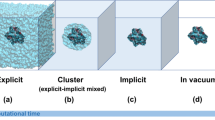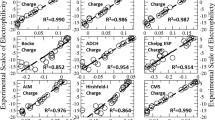Abstract
The hydrolysis reactions of methane and halomethanes have been systematically investigated using density functional theory. These reactions may occur via a metathesis mechanism and a direct-elimination mechanism, metathesis being the predominant pathway with the formation of methanol and HX (X = H, F, Cl, Br, I). The energy barriers of the predominant gas-phase hydrolysis pathway for CH4, CH3F, CH3Cl, CH3Br, and CH3I are 92.9, 19.3, 25.1, 18.8, and 20.8 kcal/mol, respectively. These values change to 92.6, 20.0, 22.8, 16.3, and 18.3 kcal/mol, respectively, when polarizable continuum model implicit solvent effect is employed. The catalytic influence of molecular water and the bulk solvent effect of water have been revealed. It was also determined that the energy barrier initially decreased and then increased with an increase in the number of water molecules. For CH4 and CH3F, there are four reactive H2O molecules taking part in the proton transfer during hydrolysis to form ten-member rings in the transition state, and two other H2O molecules participate as solvents in the predominant route. For CH3Cl, CH3Br, and CH3I, there are three H2O molecules that form eight-member rings transition state and other 2H2O molecules that act as solvent in the predominant hydrolysis pathway. Additional H2O molecules as an explicit solvent are investigated using the ONIOM model, and the coulomb interaction between adjacent atoms of the transition state is calculated to investigate the inherent reason for the formation of HF in the gas phase and (H3O+ + F−) in a solvent. These intrinsic mechanistic insights should facilitate a deeper understanding of halomethanes hydrolysis.







Similar content being viewed by others
References
Habartová A, Hormain L, Pluhařová E, Briquez S, Monnerville M, Toubin C, Roeselová M (2015) Molecular simulations of halomethanes at the air/ice interface. J Phys Chem A 119(39):10052–10059
Hossaini R, Chipperfield MP, Saiz-Lopez A, Harrison JJ, Glasow R, Sommariva R, Atlas E, Navarro M, Montzka SA, Feng W, Dhomse S, Harth C, Mühle J, Lunder C, O’Doherty S, Young D, Reimann S, Vollmer MK, Krummel PB, Bernath PF (2015) Growth in stratospheric chlorine from short-lived chemicals not controlled by the Montreal Protocol. Geophys Res Lett 42(11):4573–4580
Aschmann J, Sinnhuber BM (2013) Contribution of very short-lived substances to stratospheric bromine loading: uncertainties and constraints. Atmos Chem Phys 13(3):1203–1219
Abbatt JPD, Thomas JL, Abrahamsson K, Boxe C, Granfors A, Jones AE, King MD, Saiz-Lopez A, Shepson PB, Sodeau J, Toohey DW, Toubin C, von Glasow R, Wren SN, Yang X (2012) Halogen activation via interactions with environmental ice and snow in the polar lower troposphere and other regions. Atmos Chem Phys 12(14):6237–6271
Verhulst KR, Aydin M, Saltzman ES (2013) Methyl chloride variability in the Taylor Dome ice core during the Holocene. J Geophys Res: Atmos 118(21):218–228
Karlsson A, Theorin M, Abrahamsson K (2013) Distribution, transport, and production of volatile halocarbons in the upper waters of the ice-covered high Arctic Ocean. Global Biogeochem Cy 27(4):1246–1261
Saltzman ES, Aydin M, Tatum C, Williams MB (2008) 2000-year record of atmospheric methyl bromide from a South Pole ice core. J Geophys Res: Atmos 113:(D5)
Harper K, Minofar B, Sierra-Hernandez MR, Casillas-Ituarte NN, Roeselova M, Allen HC (2009) Surface residence and uptake of methyl chloride and methyl alcohol at the air/water interface studied by vibrational sum frequency spectroscopy and molecular dynamics. J Phys Chem A 113(10):2015–2024
Hauchecorne D, Herrebout WA (2013) Experimental characterization of C–X···Y–C (X=Br, I; Y=F, Cl) halogen-halogen bonds. J Phys Chem A 117(45):11548–11557
Lu Y, Zou J, Wang H, Yu Q, Zhang H, Jiang Y (2005) Triangular halogen trimers. A DFT study of the structure, cooperativity, and vibrational properties. J Phys Chem A 109(51):11956–11961
Wang B-S, Hou H, Gu Y-S (1999) Theoretical investigation of the reactions of O (3P) with CH 3 F and CH 2 F 2. Chem Phys 247(2):201–206
Espinosa-García J, Coitiño E-L, González-Lafont A, Lluch J-M (1998) Reaction-path and dual-level dynamics calculations of the CH3F + OH reaction. J Phys Chem A 102(52):10715–10722
Glew D, Moelwyn-Hughes E (1952) The kinetics of the acid and alkaline hydrolysis of methyl fluoride in water. Proc R Soc London, Ser A 211(1105):254–265
Frisch M, Trucks G, Schlegel HB, Scuseria GE, Robb MA, Cheeseman JR, Scalmani G, Barone V, Mennucci B, Petersson GJI, Wallingford, CT (2009) Gaussian 09, revision a. 02, gaussian. 200
Becke A-D (1993) Density functional thermochemistry. III. The role of exact exchange. J Chem Phys 98(7):5648–5652
Lee C, Yang W, Parr R-G (1988) Development of the Colle-Salvetti correlation-energy formula into a functional of the electron density. Phys Rev B 37(2):785–789
Ditchfield R, Hehre WJ, Pople JA (1971) Self consistent molecular orbital Methods. IX. An extended Gaussian type basis for molecular orbital studies of organic molecules. J Chem Phys 54(2):724–728
Hehre WJ, Ditchfield R, Pople JA (1972) Self—consistent molecular orbital Methods. XII. Further extensions of Gaussian—type basis sets for use in molecular orbital studies of organic molecules. J Chem Phys 56(5):2257–2261
Rassolov VA, Pople JA, Ratner MA, Windus TL (1998) 6-31G* basis set for atoms K through Zn. J Chem Phys 109(4):1223–1229
Wadt W-R, Hay P-J (1985) Ab initio effective core potentials for molecular calculations. Potentials for main group elements Na to Bi. J Chem Phys 82(1):284–298
Raghavachari K, Trucks G-W, Pople J-A, Head-Gordon M (1989) A fifth-order perturbation comparison of electron correlation theories. Chem Phys Lett 157(6):479–483
Fukui K, Kato S, Fujimoto H (1975) Constituent analysis of the potential gradient along a reaction coordinate. Method and an application to methane + tritium reaction. J Am Chem Soc 97(1):1–7
Fuentealba P, Preuss H, Stoll H, Von Szentpály L (1982) A proper account of core-polarization with pseudopotentials: single valence-electron alkali compounds. Chem Phys Lett 89(5):418–422
Chem A (1992) Janaf thermochemical tables. Anal Chem 64(8):502A–502A
Egawa T, Yamamoto S, Nakata M, Kuchitsu K (1987) Average and equilibrium structures of methyl flouride studied by electron diffraction. A joint analysis with rotational constants and cubic force constants. J Mol Struct: Theochem 156(3–4):213–228
Jensen P, Brodersen S, Guelachvili G (1981) Determination of A0 for CH335Cl and CH337Cl from the ν4 infrared and Raman bands. J Mol Spectrosc 88(2):378–393
Carme Rovira M, Novoa J-J, Whangbo M-H, Williams J-M (1995) Ab initio computation of the potential energy surfaces of the water·hydrocarbon complexes H2O·C2H2, H2O·C2H4 and H2O·CH4: minimum energy structures, vibrational frequencies and hydrogen bond energies. Chem Phys 200(3):319–335
Zheng S, Xiong Y, Wang J (2010) Theoretical studies on identity S(N)2 reactions of lithium halide and methyl halide: a microhydration model. J Mol Model 16(12):1931–1937
Xiong Y, H-j Zhu, Ren Y (2003) A theoretical study of the gas-phase ion pair SN2 reactions of lithium halide and methyl halide with inversion and retention mechanisms. J Mol Struct: Theochem 664–665:279–289
D. R. Linde (1991) CRC Handbook of Chemistry and Physics, 72th edition
Graner G (1981) The methyl bromide molecule: a critical consideration of perturbations in spectra. J Mol Spectrosc 90(2):394–438
Harmony MD, Laurie VW, Kuczkowski RL, Schwendeman RH, Ramsay DA, Lovas FJ, Lafferty WJ, Maki AG (1979) Molecular structures of gas-phase polyatomic molecules determined by spectroscopic methods. J Phys Chem Ref Data 8(3):619–722
Kamerlin SCL, Haranczyk M, Warshel A (2009) Are mixed explicit/implicit solvation models reliable for studying phosphate hydrolysis? A comparative study of continuum, explicit and mixed solvation models. Chem Phys Chem 10(7):1125–1134
Svensson M, Humbel S, Froese R-DJ, Matsubara T, Sieber S, Morokuma K (1996) ONIOM: A multilayered integrated MO + MM method for geometry optimizations and single point energy predictions. A test for diels − alder reactions and Pt(P(t-Bu)3)2 + H2Oxidative addition. J Phys Chem 100(50):19357–19363
Barin II (1989) Thermochemical data of pure substances, 3rd edn. VCH, Weinheim
Mushrif SH, Varghese JJ, Vlachos DG (2014) Insights into the Cr(iii) catalyzed isomerization mechanism of glucose to fructose in the presence of water using ab initio molecular dynamics. Phys Chem Chem Phys 16(36):19564–19572
Acknowledgements
This work was financially supported by the National Natural Science Foundation of China (51801058; 51372077) and Science-Technology Innovative Research Team for Excellent Middle-aged and Young Scientist in Higher Education Institutions of Hubei Province of China (T201626).
Author information
Authors and Affiliations
Corresponding authors
Electronic supplementary material
Below is the link to the electronic supplementary material.
Rights and permissions
About this article
Cite this article
Ruan, M., Hou, H., Wang, B. et al. Computational study on the hydrolysis of halomethanes. Theor Chem Acc 137, 181 (2018). https://doi.org/10.1007/s00214-018-2389-7
Received:
Accepted:
Published:
DOI: https://doi.org/10.1007/s00214-018-2389-7




